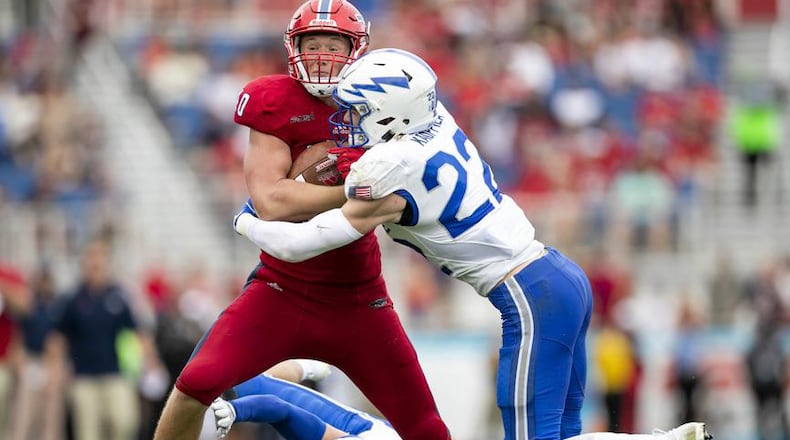Harrison Bryant was a two-time all-state high school football player whose teams regularly contended for state titles.
Yet outside of The Union Recorder of Milledgeville and sometimes The Macon Telegraph, not much was written about the player who would go on to win the John Mackey Award as college football's best tight end in 2019. This week, Bryant is expected to be among the first 100 players taken in the NFL draft.
Bryant played at John Milledge Academy, a Baldwin County private school that competes in the Georgia Independent School Association.
Founded in 1986, GISA is an association of small private schools, 31 that play 11-man football, almost all of them outside of metro Atlanta. GISA has long been obscured by the Georgia High School Association, which has some 420 football-playing schools, some with more than 3,000 students.
“There’s players here, man,’’ said J.T. Wall, the football coach at John Milledge Academy, the reigning GISA Class AAA football champion. “There’s been players for a long time. They’re here for a better education, a better environment. We’ve had some very good players over the years that have been overlooked. That’s changing with guys like Harrison and social media getting their film out.’’
This week, Bryant likely will become the sixth GISA player to be taken in the NFL draft. ESPN rates him the No. 77 overall prospect, which is third-round territory. That would be the highest for any former GISA player.
Wall, a John Milledge Academy graduate and a former University of Georgia fullback, went in the seventh round of the 2000 NFL draft, though he played only briefly in the league. Others from GISA who have been drafted are wide receiver DeAndre Smelter of Tattnall Square in 2015, punter Durant Brooks of Tattnall Square in 2008, defensive tackle Le Kevin Smith of Stratford Academy in 2006 and punter Chris Mohr of Briarwood Academy in 1989.
According to the research of Steve Slay of the Georgia High School Football Historians Association, there were 73 former GISA players on college football rosters last season. That was a smidgen of the 4,488 overall from Georgia schools. Another 48 Georgia college players come from other non-GHSA schools or home-school teams.
Bryant came to John Milledge Academy as a junior in 2015, a transfer from a GHSA school, Jones County. He weighed 220 pounds, making him the third-heaviest player that Wall had, so Wall made him a tackle and defensive end.
The new player made all-state, and John Milledge Academy reached the state semifinals. For his senior season, Bryant wanted to play tight end. He was 6-foot-5, 230 pounds, and among the team’s fastest players.
“With a little convincing from him and talking with our coaches, we moved him,’’ Wall said. “He got his cousin to come out and give us another lineman to take his place. Once we started messing with the idea, it was like ‘holy cow.’ Our rule was that if it was single coverage, we threw it to him. We played him at wildcat. He even completed a pass. He had great hands and footwork. And he was a coach’s dream.’’
When Bryant played tackle, the team completed 37 passes all season. With him at tight end, Bryant alone caught 39 passes. Bryant also had 100 tackles, 14 for losses, and 11 sacks.
That wasn’t enough to generate major Power 5 conference offers. Samford, an FCS program, was the first to recruit him. Samford offensive coordinator Travis Trickett was hired by Lane Kiffin to join Florida Atlantic’s staff and recruited Bryant to come there.
At FAU, Bryant played sparingly as a freshman but caught 32 passes as a sophomore. As a senior, he had 65 receptions for 1,004 yards. But he’s actually considered a better blocker than receiver, so that season at left tackle for John Milledge Academy didn’t hurt him.
“He’s definitely helped us as far as more college coaches coming through the door,” Wall said. “A couple of our guys are going to sign this year. Harrison comes back and works out during spring break. That’s great for our kids to see how hard he works.’’
John Milledge Academy senior Mark Folston, who rushed for 423 yards in the state-championship game last season, has committed to Virginia.
Wall said that Bryant would’ve had opportunities in the ACC or SEC had there been film of him playing tight end sooner, or if social media had become the recruiting catalyst that it is today.
“The recruiting game wasn’t like it is now as far as social media,” Wall said. “Everything was still by email and phone calls. This Twitter thing has gone crazy. These guys are one click away. It used to be you’d get a letter in the mail and think you’ve done something, but these coaches can take a look at you now.’’
Although John Milledge Academy and other small schools are thriving, the future of GISA football remains uncertain. The association began eight-man football in 2019 to help schools with smaller numbers. Old powerhouses such as Stratford Academy and Tattnall Square of Macon moved to the GHSA a few years ago. Next season, Deerfield-Windsor of Albany, Loganville Christian and Heritage School of Newnan are joining the GHSA.
But Wall believes that GISA and John Milledge Academy will continue to produce college players as long as they’re fielding teams.
“There’s good players everywhere,” Wall said “We’ve got to promote them as high school coaches, and college coaches have to work harder to find these guys. They’re not all at the (GHSA) 6A and 7A levels. Every school’s got its positives and negatives. Bigger is good for some kids, smaller for some. Every school and program has their place. Hard workers are going to be found, and they’re going to be found wherever they’re at.”
About the Author
The Latest
Featured


